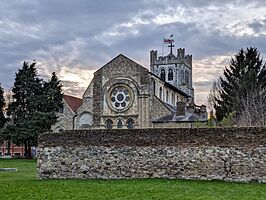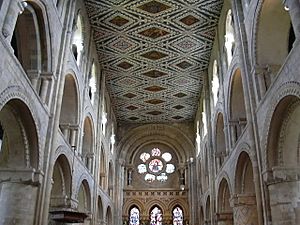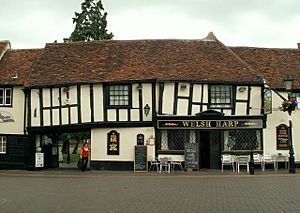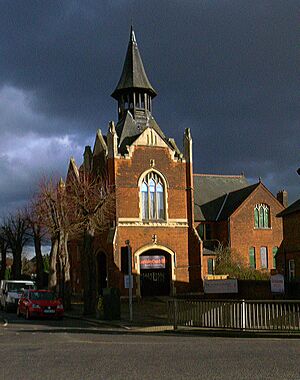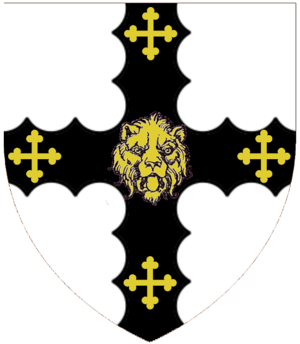Waltham Abbey facts for kids
Quick facts for kids Waltham Abbey |
|
|---|---|
|
Clockwise from top: Waltham Abbey Church and ruins, the Royal Gunpowder Mills, pedestrianised Sun Street, the Welsh Harp public house, and Waltham Abbey Town Hall
|
|
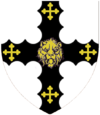 Coat of arms of Waltham Abbey |
|
| Area | 16.3746 sq mi (42.410 km2) |
| Population | 22,859 (2021 census) |
| • Density | 1,396/sq mi (539/km2) |
| OS grid reference | TL385005 |
| • Charing Cross | 14 mi (23 km) SW |
| Civil parish |
|
| District | |
| Shire county | |
| Region | |
| Country | England |
| Sovereign state | United Kingdom |
| Post town | WALTHAM ABBEY |
| Postcode district | EN9 |
| Post town | LONDON |
| Postcode district | E4 |
| Post town | LOUGHTON |
| Postcode district | IG10 |
| Dialling code | 01992 020 |
| EU Parliament | East of England |
| UK Parliament |
|
Waltham Abbey is a town in Essex, England. It is located near London, about 22 kilometers (13.5 miles) north-east of Charing Cross. The town sits on the Greenwich Meridian line. It is found between the River Lea to the west and Epping Forest to the east. Many parts of the town are protected as part of the Metropolitan Green Belt.
Waltham Abbey is close to several other towns. These include Chingford to the south and Loughton to the east. To the west are Cheshunt and Waltham Cross. The town's population was 22,859 in the 2021 census.
The town is famous for its old abbey. This abbey, called the Abbey Church of Waltham Holy Cross and St Lawrence, was the last one in England to be closed down. It has been a place of worship since the 600s. It became a popular place for pilgrimage in the 1000s. This was after a story about a "Holy Cross" became well known. King Harold Godwinson, the last Anglo-Saxon king, rebuilt the church in 1060. Many believe he was buried here after the Battle of Hastings in 1066.
Today, the abbey grounds are open to the public as Waltham Abbey Gardens. They are looked after by the Lee Valley Regional Park Authority. Epping Forest is along the eastern side of the town. The Royal Gunpowder Mills are also in Waltham Abbey. They were used to make explosives for over 300 years. This site is now a special historical and nature area. The Lee Valley White Water Centre, which hosted the canoe slalom for the 2012 Summer Olympics, is also nearby.
Contents
What's in a Name?
The name Waltham comes from old words. Weald or wald means "forest." Ham means "homestead" or "enclosure." So, Waltham means "homestead in the forest."
The old name for the area was "Waltham Holy Cross." This name was used for official town matters. "Waltham Abbey" was used for church matters. People started calling the main town "Waltham Abbey" around the 1500s. But the official name didn't change until 1974. That's when the local area was officially named Waltham Abbey.
A Look Back in Time
Early Days
People have lived in Waltham Abbey for a very long time. There are signs of people living here even before the Romans arrived. The Roman road, Ermine Street, is not far away. There's a local story that Boudica, a famous British queen, ended her fight against the Romans nearby. She is said to have poisoned herself with a plant from the banks of Cobbins Brook.
A church has stood where Waltham Abbey Church is now since the 600s. Old foundations of a wooden church have been found. Some jewelry from the 600s was also found. This shows how old the site is.
The Abbey's Importance
The town's recorded history began in the early 1000s. This was during the time of King Canute. His flag-bearer, Tovi the Proud, built a church here. It was built to hold a special cross found in Montacute. This cross gave Waltham its "Holy Cross" name.
After Tovi died, Edward the Confessor gave the land to Harold Godwinson. Harold later became king. He rebuilt Tovi's church in stone around 1060. He did this because he believed praying to the cross had cured him. The people of Waltham used the abbey as their main church.
A famous story says that after King Harold died at the Battle of Hastings in 1066, his body was brought to Waltham. He was supposedly buried near the main altar. Today, a stone slab in the churchyard marks this spot.

In 1177, King Henry II made Harold's church into a priory. This was part of his apology for the murder of Thomas Becket. Later, in 1184, it became a full abbey. It grew to be the richest monastery in Essex. The town grew around the abbey.
In 1189, Richard the Lionheart gave the town permission to hold regular markets and fairs. The market still happens today on Tuesdays and Saturdays.
King Henry VIII often visited Waltham Abbey. He is thought to have had a house near the abbey. In 1532, he and Anne Boleyn stayed there for five days. The abbey was closed down and partly destroyed in 1540. It was the very last abbey to be closed in England. After this, the town became less important.
Later Times
In the 1600s, a gunpowder factory opened in Waltham Abbey. This was because of the good river connections and empty marshland. The factory was sold to the government in 1787. It grew much bigger over the next 100 years. It became known as the Waltham Abbey Royal Gunpowder Mills. New types of explosives were developed here.
During World War II, the factory was a target. A German V-2 rocket landed nearby in 1945. It caused a lot of damage and loss of life. The factory closed in 1943. The site is now used for explosives research. Other industries in the past included silk and fabric printing. The River Lee Navigation was improved in 1769, which brought more trade to the town.
In the early 1900s, the area had many glass-houses and market gardens. Digging for gravel was also a big industry. This left many pits that are now used for fun and are home to wildlife. In the 1960s and 1970s, the town's population grew. New homes were built, and parts of the town centre were rebuilt.
Town Management
Waltham Abbey has three levels of local government. These are the Waltham Abbey Town Council, Epping Forest District Council, and Essex County Council. The Town Council works from the Waltham Abbey Town Hall. This building has been its home since 1904.
Waltham Abbey is part of the Epping Forest area for national elections. This area has been represented by Dr Neil Hudson since 2024. Before 1974, the town was part of the Epping area. Sir Winston Churchill was an MP for this area from 1924 to 1945.
Where is Waltham Abbey?
The River Lea forms the western edge of the town. This river is also the border with Hertfordshire. The eastern edge of the town runs through Epping Forest. The land gently rises from the river's marshes and meadows. It goes up to a small flat area of clay in the east. This area is 60–90 meters (about 200-300 feet) above sea level.
The M25 motorway runs south of the town. You can get onto it at Junction 26. The main roads through the town are the A112 and A121.
The parish of Waltham Abbey includes other small villages and hamlets. These are High Beach, Holyfield, Sewardstone, and Upshire.
Waterways
Many channels have been dug over time to divide the River Lea. These channels help drain the land to the west. They flow south through parts of Waltham Abbey. Some of these are:
- Cornmill Stream
- Old River Lea
- Millhead Stream
- River Lee Flood Relief Channel
- River Lee Navigation
- Small River Lea
Cobbins Brook also flows through the town from the east.
 |
across Cheshunt Marsh Cheshunt |
across rolling Green Belt Lower Nazeing |
within rural Epping Upland Epping Green |
 |
| across the River Lea Waltham Cross |
across Epping Forest Epping and Theydon Bois |
|||
| across the River Lea Enfield |
Chingford | across Epping Forest Loughton |

Who Lives Here?
In 2021, the population of Waltham Abbey was 22,859. This was an increase from 21,149 in 2011. Most people (82%) live in the main built-up area of the town.
The 2021 census showed that 74.6% of the people in Waltham Abbey were White British. In 2011, 63.8% of the people were Christian. About 25.3% said they had no religion. Smaller groups included Muslims (1.7%) and Jewish people (1.1%).
| Waltham Abbey Population by Ethnic Group | ||||||||
|---|---|---|---|---|---|---|---|---|
| Ethnic Group | 1991 | 2001 | 2011 | 2021 | ||||
| Number | % | Number | % | Number | % | Number | % | |
| White: Total | 18,028 | 98.1% | 19,536 | 95.8% | 19,316 | 91.3% | 19,009 | 83.2% |
| White: English/Welsh/Scottish/Northern Irish/British | – | – | 18,742 | 91.9% | 18,115 | 85.7% | 17,060 | 74.6% |
| White: Irish | – | – | 266 | 1.3% | 247 | 1.2% | 276 | 1.2% |
| White: Gypsy or Irish Traveller | – | – | – | – | 36 | 0.2% | 21 | 0.1% |
| White: Romani | – | – | – | – | – | – | 34 | 0.1% |
| White: Other | – | – | 528 | 2.6% | 918 | 4.3% | 1,618 | 7.1% |
| Asian: Total | 109 | 0.6% | 249 | 1.2% | 448 | 2.1% | 810 | 3.5% |
| Asian or Asian British: Indian | 64 | 0.3% | 159 | 0.8% | 174 | 0.8% | 315 | 1.4% |
| Asian or Asian British: Pakistani | 6 | 0% | 19 | 0.1% | 70 | 0.3% | 170 | 0.7% |
| Asian or Asian British: Bangladeshi | 1 | 0% | 0 | 0% | 23 | 0.1% | 46 | 0.2% |
| Asian or Asian British: Chinese | 18 | 0.1% | 46 | 0.2% | 68 | 0.3% | 56 | 0.2% |
| Asian or Asian British: Other Asian | 20 | 0.1% | 25 | 0.1% | 113 | 0.5% | 223 | 1% |
| Black: Total | 156 | 0.8% | 328 | 1.6% | 732 | 3.5% | 1,327 | 5.8% |
| Black or Black British: African | 9 | 0% | 87 | 0.4% | 295 | 1.4% | 605 | 2.6% |
| Black or Black British: Caribbean | 93 | 0.5% | 213 | 1% | 363 | 1.7% | 522 | 2.3% |
| Black or Black British: Other Black | 54 | 0.3% | 28 | 0.1% | 74 | 0.3% | 200 | 0.9% |
| Mixed: Total | – | – | 236 | 1.2% | 528 | 2.5% | 1,008 | 4.4% |
| Mixed: White and Black Caribbean | – | – | 113 | 0.6% | 237 | 1.1% | 384 | 1.7% |
| Mixed: White and Black African | – | – | 25 | 0.1% | 46 | 0.2% | 138 | 0.6% |
| Mixed: White and Asian | – | – | 57 | 0.3% | 129 | 0.6% | 165 | 0.7% |
| Mixed: Other Mixed | – | – | 41 | 0.2% | 116 | 0.5% | 321 | 1.4% |
| Other: Total | 83 | 0.5% | 39 | 0.2% | 125 | 0.6% | 705 | 3.1% |
| Other: Arab | – | – | – | – | 23 | 0.1% | 63 | 0.3% |
| Other: Any other ethnic group | 83 | 0.5% | 39 | 0.2% | 102 | 0.5% | 642 | 2.8% |
| Total | 18,376 | 100% | 20,388 | 100% | 21,149 | 100% | 22,859 | 100% |
Places to See
Abbey Church
The old Waltham Abbey Church is still used as a church today. Other parts of the old abbey remain. These include the Midnight Chapel, the gatehouse, and Harold's Bridge. They are cared for by English Heritage.
The grounds are famous for the believed grave of King Harold II. He was the last Anglo-Saxon King of England.
Local Museum
The Epping Forest District Museum is in a building from the 1520s. It tells the story of people who have lived and worked in this area. It covers history from ancient times to today.
Royal Gunpowder Mills
There is another museum at the site of the old gunpowder factory. It shows how explosives were made and how the Royal Gunpowder Mills grew. You can see interactive displays and old exhibits. The site also has events where people act out history. There is a nature walk to explore the wildlife that has returned to the area.
Interesting Buildings
- The Welsh Harp in the Market Square is an old inn. It has a half-timbered style and is mostly from the 1400s.
- A building that used to be an inn is now a barbershop. It has a carved wooden support for its upper floor.
- Waltham Abbey Town Hall was built in 1904. It is a beautiful example of Art Nouveau style.
- Essex House and St. Kilda's are two notable buildings from the 1700s.
- At Upshire, there are cottages called the Blue Row. They have weatherboarded walls and roofs with bark still visible.
Nature and Parks
The old gravel pits in the Lea Valley are now part of the Lee Valley Regional Park. This park is used for fun activities and to protect nature.
The Epping Forest Conservation Centre in High Beach helps visitors. It provides maps, books, and information about the forest.
Getting Around
Trains and Tube
Waltham Abbey does not have its own train or tube station. However, there are stations nearby.
The closest train station is Waltham Cross. It is about a mile from the town centre. Trains from here go to London Liverpool Street and Stratford. This station opened in 1840.
Other nearby stations include Chingford and Cheshunt. The nearest London Underground station is Loughton, on the Central line.
Buses
Local bus services are run by different companies. There are bus routes to Cheshunt, Epping, Harlow, Loughton, and Waltham Cross.
Roads
The M25 motorway goes through the town. You can get on it at Junction 26. The main roads in the town are the A112 and A121.
Faith in Waltham Abbey
The Anglican abbey church is named after St Lawrence. The town also has a Catholic church. For many years, this church was in an old Methodist chapel. In 2008, the Catholic church moved to a new building. The old building was then sold to an Evangelical Free church.
Sports and Fun
Waltham Abbey has a football club called Waltham Abbey F.C.. They play at Capershotts.
The town is also home to the Essex Arrows Baseball Club. This club was started in 1981 by Louis Courtney.
Famous People from Waltham Abbey
Many interesting people have connections to Waltham Abbey:
- Sir William Wilkinson Addison (1905–1992), a historian.
- Sir John Anderson (1814–1886), an engineer and inventor.
- Queen Anne Boleyn (c.1501–1536), second wife of King Henry VIII, visited the abbey.
- Mel Calman (1931–1994), a cartoonist, is buried here.
- Thomas Fuller (1608–1661), a churchman and historian.
- John Foxe (1516–1587), author of Foxe's Book of Martyrs, lived in the town.
- Jade Goody (1981–2009), a media personality, died in Upshire.
- King Harold II (1022–1066), the last Anglo-Saxon English king, is believed to be buried here.
- King Henry VIII (1491–1547), often visited the town.
- Linda Lewis (1950–2023), a singer and songwriter, died in Waltham Abbey.
- Kenny Morris (born 1957), a drummer from Siouxsie and the Banshees.
- Connor Ogilvie (born 1996), a footballer for Portsmouth F.C., was born here.
- Fiona Pennie (born 1982), an Olympic slalom canoeist, lives here.
- Sir Alf Ramsey (1920–1999), a famous football player and manager.
- Kate Silverton (born 1970), a journalist and BBC News presenter, was born and grew up here.
- Thomas Tallis (c. 1505–1585), a famous composer, worked at Waltham Abbey.
- Alfred, Lord Tennyson (1809–1892), a famous poet, lived nearby.
Coat of Arms
See also
 In Spanish: Waltham Abbey para niños
In Spanish: Waltham Abbey para niños


